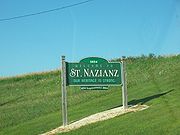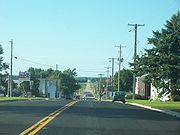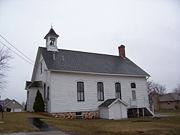
St. Nazianz, Wisconsin
Encyclopedia



Manitowoc County, Wisconsin
Manitowoc County is a county in the U.S. state of Wisconsin. As of 2000, the population was 82,887. Its county seat is Manitowoc. The United States Census Bureau's Manitowoc Micropolitan Statistical Area includes all of Manitowoc County.-Government:...
, Wisconsin
Wisconsin
Wisconsin is a U.S. state located in the north-central United States and is part of the Midwest. It is bordered by Minnesota to the west, Iowa to the southwest, Illinois to the south, Lake Michigan to the east, Michigan to the northeast, and Lake Superior to the north. Wisconsin's capital is...
, United States
United States
The United States of America is a federal constitutional republic comprising fifty states and a federal district...
founded in 1854.The population was 749 at the 2000 census.
The first 100 years
St. Nazianz was organized in 1854 as a religious colony by a group of German immigrants, led by Fr. Ambrose OschwaldAmbrose Oschwald
The Reverend Ambrose Oschwald was a Roman Catholic priest. Ordained to the priesthood on August 1, 1833, Oschwald came to Wisconsin to form a religious haven for the members of his congregation in August 1854 which became the town of St. Nazianz, Wisconsin, located at what became the John F...
, a Roman Catholic priest. The first settlers in the Oschwald group numbered 113 and came to the United States
United States
The United States of America is a federal constitutional republic comprising fifty states and a federal district...
from the Black Forest
Black Forest
The Black Forest is a wooded mountain range in Baden-Württemberg, southwestern Germany. It is bordered by the Rhine valley to the west and south. The highest peak is the Feldberg with an elevation of 1,493 metres ....
of Baden, Germany, seeking religious freedom.
Father Oschwald and his group sailed for America during the Feast of Corpus Christi in 1854, on two separate ships. The voyage of one lasted 52 days, and the other 55 days. By the time they arrived in Milwaukee by train, Several of the group had died. Father Oschwald bought 3840 acres (15.5 km²) of land in Manitowoc County for $3.50 per acre. His down payment was $1,500, with the rest paid in five installments.
In late August 1854, Father Oschwald sent six men to locate the land he had purchased, and they took a boat from Milwaukee to Manitowoc
Manitowoc, Wisconsin
Manitowoc is a city in and the county seat of Manitowoc County, Wisconsin, United States. The city is located on Lake Michigan at the mouth of the Manitowoc River. According to the 2000 census, Manitowoc had a population of 34,053, with over 50,000 residents in the surrounding communities...
, the county seat. They then headed west by oxcart, getting as far as the place where Valders now stands. They then cut their way through the dense forest, arriving at their destination on August 27. The men named the site St. Nazianz, in honor of Gregory Nazianzus. Father Oschwald followed on September 1 with more men, and the group began working to clear the land and build log houses. Soon after, work started on the community's first church, a 32-by-24-foot structure, which was built by hand. By October 21, the church was half completed, and Father Oschwald celebrated the first Mass.
Settlers began going by the name "The Association" and agreed to share everything in common and work without pay. That arrangement continued until 1896. The group built shops and mills and the community was thriving within just a few years of its start. People began practicing trades, including blacksmithing, carpentry
Carpentry
A carpenter is a skilled craftsperson who works with timber to construct, install and maintain buildings, furniture, and other objects. The work, known as carpentry, may involve manual labor and work outdoors....
, masonry
Masonry
Masonry is the building of structures from individual units laid in and bound together by mortar; the term masonry can also refer to the units themselves. The common materials of masonry construction are brick, stone, marble, granite, travertine, limestone; concrete block, glass block, stucco, and...
, shoemaking
Shoemaking
Shoemaking is the process of making footwear. Originally, shoes were made one at a time by hand. Traditional handicraft shoemaking has now been largely superseded in volume of shoes produced by industrial mass production of footwear, but not necessarily in quality, attention to detail, or...
, woodworking
Woodworking
Woodworking is the process of building, making or carving something using wood.-History:Along with stone, mud, and animal parts, wood was one of the first materials worked by early humans. Microwear analysis of the Mousterian stone tools used by the Neanderthals show that many were used to work wood...
, tailoring, barrel making, rope making, tanning
Tanning
Tanning is the making of leather from the skins of animals which does not easily decompose. Traditionally, tanning used tannin, an acidic chemical compound from which the tanning process draws its name . Coloring may occur during tanning...
, weaving
Weaving
Weaving is a method of fabric production in which two distinct sets of yarns or threads are interlaced at right angles to form a fabric or cloth. The other methods are knitting, lace making and felting. The longitudinal threads are called the warp and the lateral threads are the weft or filling...
, brick-making, baking
Baking
Baking is the technique of prolonged cooking of food by dry heat acting by convection, and not by radiation, normally in an oven, but also in hot ashes, or on hot stones. It is primarily used for the preparation of bread, cakes, pastries and pies, tarts, quiches, cookies and crackers. Such items...
, and brewing
Brewing
Brewing is the production of beer through steeping a starch source in water and then fermenting with yeast. Brewing has taken place since around the 6th millennium BCE, and archeological evidence suggests that this technique was used in ancient Egypt...
.
In the ensuing years, Father Oschwald helped start several religious organizations, including the Oschwald Brothers and Sisters of the Third Order. Father Oschwald died on February 27, 1873, and was buried under the altar at the old St. Ambrose Church at the Loreto Monastery. Several years later his body was moved to a shrine near Loreto Chapel in the village.
The Salvatorian Priests & Brothers came to St. Nazianz in 1896, 15 years after the Society of the Divine Savior was founded by Father Francis Mary of the Cross Jordan
Francis Mary of the Cross Jordan
Francis Mary of the Cross Jordan was a Roman Catholic priest and the founder of the Salvatorian Roman Catholic religious order – The Society of the Divine Savior....
in Italy
Italy
Italy , officially the Italian Republic languages]] under the European Charter for Regional or Minority Languages. In each of these, Italy's official name is as follows:;;;;;;;;), is a unitary parliamentary republic in South-Central Europe. To the north it borders France, Switzerland, Austria and...
. The Salvatorian Priests & Brothers and the Salvatorian Sisters continued to work to improve the holding of the former association, and built St. Ambrose Church
St. Ambrose Church
St. Ambrose Church is a Roman Catholic church in St. Nazianz, Wisconsin. It was built in 1898. In 1854 An entire Catholic parish in a small German village uprooted under the leadership of its priest, Father Ambrose Oschwald, and departed for America....
in 1898.
20th century
Shortly before noon on May 12, 2000, St. Nazianz and surrounding communities were hit by a severe storm that caused major damage. The storm was initially considered a tornado but was later declared a "thunderstorm super cell moist microburst" by meteorologists. It was reported that the storm produced 120 mi/h straight line winds. The National Weather Service reported that at least 75 mi/h wind gusts were achieved. Residents who were in St. Nazianz as the storm hit said that it went from noon light to midnight darkness in a matter of seconds.The storm roughly followed U.S. Route 151
U.S. Route 151
U.S. Route 151 is a U.S. Highway that runs through the states of Iowa and Wisconsin. The southern terminus for U.S. 151 is at a junction with Interstate 80 in Iowa County, Iowa, and its northern terminus is at Manitowoc, Wisconsin. The route, from south to north follows a northeasterly path through...
, with St. Nazianz and Chilton
Chilton, Wisconsin
Chilton is a city in and county seat of Calumet County in the U.S. state of Wisconsin. The population was 3,708 at the 2000 census. The city is located partially within the Town of Chilton.-History:...
receiving the worst of the damage, caused largely by wind and hail. The hail ranged from golf ball-size to baseball-size. Many houses were destroyed by the storm, while others sustained major damage. Many cars were totaled or needed hail damage repair. The total damage caused by this storm to St. Nazianz and surrounding areas was estimated at $122 million. No casualties were caused by the storm. The village has since recovered considerably.
Geography
St. Nazianz is located at 44°0′21"N 87°55′25"W (44.005717, -87.923604).According to the United States Census Bureau
United States Census Bureau
The United States Census Bureau is the government agency that is responsible for the United States Census. It also gathers other national demographic and economic data...
, the village has a total area of 0.8 square miles (2.2 km²), of which, 0.8 square miles (2.1 km²) of it is land and 1.19% is water.
Demographics
As of the censusCensus
A census is the procedure of systematically acquiring and recording information about the members of a given population. It is a regularly occurring and official count of a particular population. The term is used mostly in connection with national population and housing censuses; other common...
of 2000, there were 749 people, 296 households, and 197 families residing in the village. The population density
Population density
Population density is a measurement of population per unit area or unit volume. It is frequently applied to living organisms, and particularly to humans...
was 907.6 people per square mile (348.4/km²). There were 302 housing units at an average density of 365.9 per square mile (140.5/km²). The racial makeup of the village was 96.80% White, 0.13% African American, 0.13% Native American, 0.13% Asian, 0.53% from other races
Race (United States Census)
Race and ethnicity in the United States Census, as defined by the Federal Office of Management and Budget and the United States Census Bureau, are self-identification data items in which residents choose the race or races with which they most closely identify, and indicate whether or not they are...
, and 2.27% from two or more races. Hispanic or Latino of any race were 2.27% of the population.
There were 296 households out of which 35.1% had children under the age of 18 living with them, 53.4% were married couples
Marriage
Marriage is a social union or legal contract between people that creates kinship. It is an institution in which interpersonal relationships, usually intimate and sexual, are acknowledged in a variety of ways, depending on the culture or subculture in which it is found...
living together, 6.8% had a female householder with no husband present, and 33.4% were non-families. 25.7% of all households were made up of individuals and 10.8% had someone living alone who was 65 years of age or older. The average household size was 2.50 and the average family size was 3.09.
In the village the population was spread out with 28.2% under the age of 18, 7.2% from 18 to 24, 29.5% from 25 to 44, 20.2% from 45 to 64, and 15.0% who were 65 years of age or older. The median age was 35 years. For every 100 females there were 103.0 males. For every 100 females age 18 and over, there were 107.7 males.
The median income for a household in the village was $40,139, and the median income for a family was $43,750. Males had a median income of $35,341 versus $22,917 for females. The per capita income
Per capita income
Per capita income or income per person is a measure of mean income within an economic aggregate, such as a country or city. It is calculated by taking a measure of all sources of income in the aggregate and dividing it by the total population...
for the village was $16,989. About 3.9% of families and 5.3% of the population were below the poverty line, including 4.1% of those under age 18 and 15.4% of those age 65 or over.
Notable people
- Victor A. MillerVictor A. MillerVictor Andrew Miller was interim Attorney General of Wisconsin from October 8 until November 25, 1974. He was appointed by Governor Patrick J. Lucey to fill a vacancy on the resignation of Robert W...
, who was Attorney General of Wisconsin, lived in St. Nazianz.

